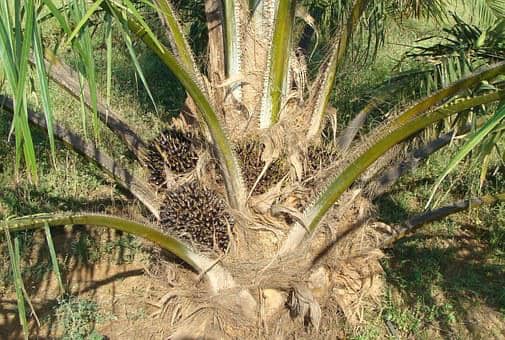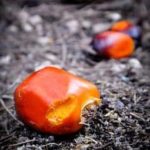Palm oil is yet another profitable farming. Palm oil plantation profit per hectare is around Rs 1,88,000 which is explained in this post.
Quick Overview – After 3-4 years yield per acre is 2 to 2.5 tons, the yield per hectare is 5 tons and the palm oil plantation profit per hectare is Rs 1,88,000.
The oil palm tree belongs to the Arecaceae family this plant is a genus of Elaeis and its scientific name is Elaeis guineensis. The tree produces edible oil and this crop is one of the highest oil-yielding plants in the world. Because of its high oil-yielding capacity, this oil crop is also known as golden palm. Palm cultivation in India is done widely on a large scale covering about 50k hectares under irrigated conditions. The beauty of this crop is it can also be cultivated under rainfed conditions.
Palm oil yield per acre per hectare per year
Age of oil palm Yield in tons per hectare per year
3 to 4 years 5 tons.
4 to 5 years 12 tons.
5 to 6 years 25 tons.
6 to 25 years 30 tons.
How to start palm oil cultivation?
If you are willing to start the cultivation then you need to follow the basic steps that are given below.
Varieties
There are mainly three varieties; all 3 types are given below.
Tenera – Tenera oil cultivation is recommended for commercial cultivation among the other two varieties. This variety is a hybrid variety between Dura and Pisifia. The Tenera variety produces fruits with high oil content. This is a cross of female shell-less pisifera and thick-shell dura male varieties. The variety itself is a thin shell variety and it is commercially cultivated throughout the world. Remember the tenera yield is much higher than the other two varieties.
Termed dura – Dura variety has a thick shell of 2 to 8 mm and it is not known for commercial cultivation.
Pisifera – Pisifera is a shell-less fruit-bearing variety.
Read this one – How many palm oil plants per acre and farm income
Climate requirement
It is a humid tropical crop that thrives best in humid conditions; the oil tree needs five to six hours of bright sunlight per day with 80% humidity for bonzer growth.
Temperature range – The temperature required for the edible oil trees is 22°C to 24°C and 20°C to 33°C.
Water requirements
Rainfall requirement – Rainfall impact on its production is optimal and the required rainfall is 2500 to 4000 mm per year. Assured irrigated conditions are considered for the cultivation due to the need for evenly distributed rainfall of 2500 to 4000 mm per year. Sufficient rainfall can enhance the oil palm yield.
Water plays an important role, by providing sufficient water farmers can win the battle and palm oil yield per acre can be expected higher. Palm oil plantation is not suitable in the water lacking region so do not plant these plants where assured irrigation is not available.
For a faster growth rate, sufficient irrigation is required for palm plants. These trees can produce high yields and biomass. Water requirements for these plants are higher and each plant needs 200 litres of water per day. The use of drip irrigation can simplify the water supply.
Soil requirements
This crop is soil-friendly and can be grown on a wide range of soil. Well-drained deep loamy moist soil, rich organic matter soil including alluvial soils are preferably selected for cultivation.
Avoid soil – The tree needs at least one-metre soil depth therefore avoid high saline soil, highly alkaline soils, and coastal sandy and water stagnation soils.
Oil palm propagation method

Seed propagation – Due to the high dormancy preheating of seeds is required for 70 to 75 days at a temperature of 40°C. After this process seeds are soaked in the running water and cooled down for 4 to 5 days. The seed germination process takes place after 10 to 12 days. After germination sprouts are transferred to polybags.
Generally, a single-stage polybag propagation method is applied in a nursery in which a polybag of size 30 to 45 is filled with topsoil sand with well-rotten manure. Then sprouts are placed at a depth of 2.5 cm in the centre of the polybag. Regular mulching and watering along with sufficient NPK are advised for proper growth of the seedling.
Seedling selection – Select around 1-meter tall healthy seedlings of 12 to 15 months old age with 12 to 15 leaves.
Land preparation
A couple of ploughing in the whole land is required in the beginning. Land should be weed-free hence, weeding is performed at regular intervals. For higher palm oil profit one should provide good organic matter to the field to make the soil rich. During the weeding process throw the tiny stones out of the field to make hand ploughing easier.
Palm oil trees per acre
I got an email from my viewer asking about how many oil palm trees in 1 acre in India can be planted. I would say in the triangular planting method 60 to 80 trees in one acre can be planted.
Palm oil trees per hectare
In the triangular planting method, 145 to 147 plants can be planted with a spacing of 9 meters x 9 meters x 9 meters with a pit size of 60 cm x 60 cm x 60 cm.
Read this – Date Palm Cultivation Project Report
Planting season
June to December is the best season for planting whereas you need to take some extra precautions during summer. Providing sufficient irrigation and mulching during the summer season is good for plant health.
Fertilizer recommendations
Soil + 400-gram single super phosphate + 50 grams phorate. To achieve a good palm oil plantation apply the above application at the base of the pit immediately after the plantation.
3 months interval – Starting from June or July 4 equal split doses of fertilizer.
2nd dose fertilizer – FYM of 75 to 100 kg or 90 to 100 kg of green manure and 5 kg neem cake applied to each tree. Remember proper watering is necessary after fertilization.
Newly planted tree – Apply first fertilizer dose after 3 months of planting.
Mulching in plantation
Mulching can be done with flower leaves, dried leaves, empty bunches, male flowers and coconut husks. Mulching is necessary to conserve soil moisture and control weed growth in plants.
Pollination for palm plants is necessary
The crop is dependent on pollination; it is a high cross-pollination crop. Insects and wind play a role in assisted pollination in oil palm. Insects such as “Elaeidobius Kamerunicus” help pollination by good fruit sets. Brandlings like Elaedobius kamerunicus are kept for 2.5 years from the planting. Keep the weevil for 3 years in case of low girth and vigour.
Weed control
Manual or chemical weeding is done in this cultivation.
Once a year – For effective weed control you can use glyphosate of 700 to 750 ml/per hectare/ per year or a 17 ml basin can be applied for the same.
Twice a year – Spraying herbicides + paraquat with atrazine, apply diuron and monuron on the ground to control the weed effectively.
Oil palm flowering
Flowering takes place after 14 to 17 months of the planting period. Both male and female flowers are produced on the same plant.
Ablation in oil palm
Ablation is the process of removing male and female flowers of oil palm trees in the early stages. The ablation process is required in this cultivation for the development of root, stem, girth and vigour. To avoid inflorescence problems in the tree you should pick the flowers manually or use the picking tools.
Pest and disease management
Pestalotiopsis leaf spot, Rhinoceros beetle, Mealybugs, Ganoderma butt rot, Bacteria bud rot, and wilt are some of the common pests and diseases found in the plantation. You should apply appropriate herbicides or recommended pesticides and can also contact the nearest agriculture department.
Harvesting process
Harvest time is approximately 3 years from the planting period. Identification of correct harvesting time plays an important role due to impacting the quality and quantity of the oil content. Start the harvesting once the fruit turns partially yellow to orange in colour. Fruits ripening can be recognised while the falling of 5 to 8 fruits from the tree. By pressing the fruit hard with a finger orange coloured oil should egress from the fruit.
Harvesting is done throughout the year in intervals of 10 to 14 days. Farmers used to pick the fruit with sharp knives or sickles.
Project Report
| Palm oil cost per hectare Plant material cost = Rs 5000. Land preparation cost = Rs 10,000. Labour cost = Rs 10,000. Fertilizer and pesticide cost = Rs 9,000. Irrigation cost = Rs 20,000. Weed removal cost = Rs 5000. Miseleneious cost = Rs 5000. Total cost = Rs 64,000. Reduce one-time investment i.e. plant cost and land preparation cost from the 1st year cost. 1st year cost = Rs 64000 – Rs 5000 – Rs 10,000 = Rs 49,000. The tree will produce yield after 3 years. Therefore, 3-year cost = Now multiply Rs 49,000 by 2 years. 3 year cost = Rs 49,000 x 2 years = Rs 98,000. Total cost for 3 years = Rs 98,000 + Rs 64,000 (1st-year cost). Total cost for 3 years = Rs 162,000. Palm oil plantation profit per hectare Yield per hectare = 5 to 8 tonnes. Let’s take 5 tonnes of palm oil production in 1 hectare. 5 tonnes in kg = 5000 kg. Palm oil rice per kg = Rs 50 to Rs 200 and more accordingly. Let’s take an average price = Rs 70 per kg. Profit per hectare = Rs 70 x 5000 kg. Profit per hectare = Rs 3,50,000. Now, let’s calculate net profit. Net profit = Profit per hectare – cost per hectare. Net Profit = Rs 3,50,000 – Rs 162,000. Net Profit = Rs 1,88,000. The estimated profit for 1 hectare is Rs 1,88,000 and the palm oil tree yield per acre might be around Rs 70,000 to Rs 80,000. Note – Profit margin for the crop may vary according to the market, transport and demand. |
FAQ
Name some highest oil-producing plants.
Approximately 70% of oil production comes from specifically 4 plants. These crops can be considered the highest oil-producing crops such as soybeans, oil palm crops, rape and sunflower.
What is palm oil plantation profit per hectare?
After deducting the cost the profit might be Rs 1,88,000 depending on the market, demand, availability and quality.
What is the oil palm ablation process?
The process when male and female flowers are removed in the early stages is known as ablation.
How many palm trees per acre should I plant?
60 to 80 palm oil trees are good to plant on 1-acre land.
How many palm trees per hectare can be planted?
140 to 150 trees are good enough to plant in 1 hectare.
How many years does it take palm oil to grow?

3 to 4 years are needed by these trees to produce oil.
How much palm oil per hectare?
After 3 years 150 trees can produce around 5 to 8 tonnes of oil per hectare.
What is NMOOP?
NMOOP stands for National Mission on Oilseeds and Oil Palm. It is a mission run by the ministry of agriculture and farmers’ welfare, the government of India.
Does India import palm oil from other countries?
In the recent past, its consumption in India increased and the government is fulfilling the need for edible palm oil through imports from Indonesia and Malaysia.
Why is palm oil in demand?
One most significant reasons behind its popularity is the high consumption of vegetable oil in food.
Read More